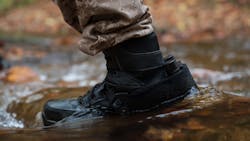Robotic Research picks tactical networking device from Persistent Systems for infantry in GPS-denied areas
CLARKSBURG, Md. – Battlefield networking experts at Robotic Research in Clarksburg, Md., needed mobile ad-hoc network technology for the company's WarLoc, a boot-worn sensor. They found their solution from Persistent Systems in New York City.
Robotic Research designers are choosing the MPU5 tactical networking device from Persistent Systems for the WarLoc networked sensor that keeps track of infantry warfighters in GPS-denied environments like caves, skyscrapers, and subway tunnels.
Robotic Research also is joining the Persistent Wave Relay Ecosystem, an industry alliance of sensor and unmanned system companies that use Persistent's Wave Relay mobile ad hoc network (MANET).
WarLoc is deployed across U.S. Army brigade combat teams and with U.S. Special Operations Command forces. to help with infantry situational awareness.
"The aim of the Wave Relay Ecosystem is to deliver the warfighter a truly unified battlefield network, where all of the sensors and unmanned systems are united to deliver the warfighter real-time situational awareness," says Jeffrey Washington, director of business development at Persistent Systems.
Likewise, Robotic Research experts also plan to include Persistent technology in the Robotic Research Pegasus II, mid-sized, transformable unmanned aerial vehicle and ground vehicle, which is part of the company's family of tactically deployable, transformable, autonomous robotic systems.
These transformable robotic systems provide the air capabilities of an unmanned helicopter and unmanned ground vehicle (UGV). Robotic Research developed Pegasus for the U.S. Defense Threat Reduction Agency (DTRA) and the U.S. Army Combat Capabilities Development Command (CCDC).
Pegasus II demonstrated aerial and ground capabilities that extend the reach of the warfighter during Project Convergence 20 last fall at Yuma Proving Ground, Ariz.
"As a Wave Relay Ecosystem Partner, we can ensure that we are building our systems to be a part of the larger, integrated warfighter network that is taking shape on the battlefield," says Alberto Lacaze, co-founder and president of Robotic Research.
Robotic Research is also the prime autonomy provider of autonomous vehicle technology for the Expedient Leader-Follower program, which enables the platooning of unmanned, autonomous trucks, reducing the number of soldiers being put in harm's way for many operational mission scenarios.
For more information contact Persistent Systems online at www.persistentsystems.com, or Robotic Research at www.roboticresearch.com.

